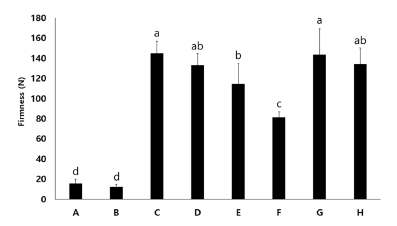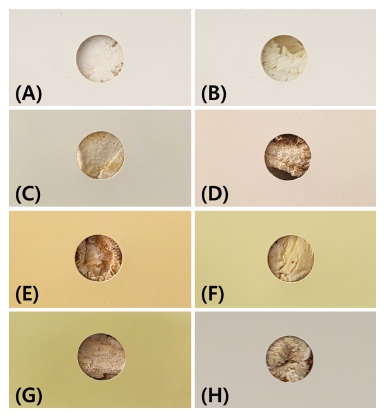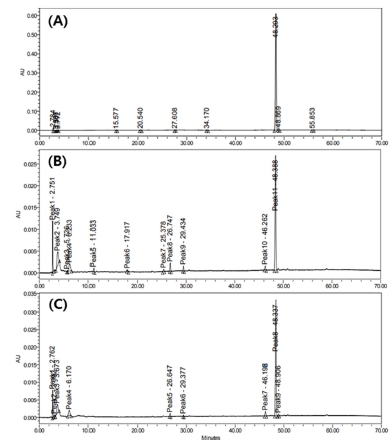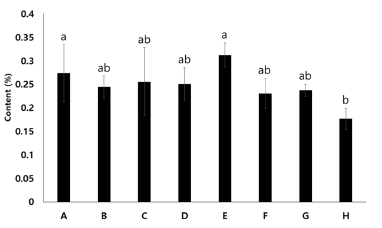
건조방법에 따른 일당귀 뿌리의 생리화학적 특성 분석
This is an open access article distributed under the terms of the Creative Commons Attribution Non-Commercial License (http://creativecommons.org/licenses/by-nc/3.0/) which permits unrestricted non-commercial use, distribution, and reproduction in any medium, provided the original work is properly cited.
Abstract
This study was conducted to confirm the morphological and compositional changes in Angelica acutiloba (Siebold & Zucc.) Kitagawa roots by different drying methods and to provide basic data for post-harvest management.
Two types of root samples, fine roots that were originally removed and samples that were sliced, were prepared. They were dried by four methods (freeze-drying, hot air-drying, shade-drying, and direct solar-drying), and the drying characteristics were investigated. Drying time was the shortest in freeze-drying, and the longest in shade-drying. The hardness of the dried roots was relatively higher in hot air- and direct solar-dried samples, and the color varied according to each drying treatments. The (Z)-ligustilide content was relatively higher in the case of freeze-dried or shade-dried samples than in other samples.
These results provide insights into the optimal post-harvest drying technology for A. acutiloba.
Keywords:
Angelica acutiloba, Drying Treatments, Hardness, Root Color, (Z)-ligustilide서 언
일당귀 [Angelica acutiloba (Siebold & Zucc.) Kitagawa]는 왜당귀, 잎당귀 등으로도 불리며, 산형과 (Family Apiaceae), 당귀속 (Genus Angelica)에 속하는 약용작물이다 (Lee, 2003; Lee et al., 2020). 국내 중·남부지역에서 주로 재배하고 있으며, 국내 소비의 증가추세에 따라 2022년 수입량 60 톤에서 2023년 70 톤으로 매년 증가하고 있다 (NIKOM, 2023).
잎은 독특한 향이 있어 쌈채소로 인기가 높고 (Choi et al., 2017; Eom et al., 2021), 약재로 이용되는 뿌리에는 (Z)-ligustilide, n-butylidenephthalide 등의 기능 성분이 포함된 것으로 알려져 있어 (Han et al., 1998; Kim et al., 2009) 항산화, 항염증, 백혈구 수 감소 억제 등 의약 분야 활용을 위한 연구가 활발히 진행되고 있다 (Kang et al., 2003b; Lee, 2008; Han, 2013; Cho et al., 2017).
약용작물을 약재로 이용시 장기보존과 저장의 편리를 위해 대부분 건조과정을 거친 후 유통되며, 적절하지 못한 건조 방법은 변질에 의한 품질 저하의 원인이 되기도 한다 (Bae and Lee, 2008). 약용작물을 건조하는 방법으로는 초저온·진공을 통해 얼음을 승화시켜 수분을 제거하는 동결건조법, 고온의 바람을 이용한 열풍건조법, 일사광을 배제한 음지건조법, 태양빛에 말리는 양지건조법 등이 활용되고 있으며 (Kim et al., 2007; Lee et al., 2014), 각각의 건조 방법에 따라 경도, 색상, 유용성분과 같은 상품성에 차이가 발생한다. 통상적으로 약용작물 고유의 특성과 활용 부위에 따라 적절한 건조 방법을 선택하게 되는데, 일당귀와 같이 뿌리를 활용하는 작물들은 주로 양지건조 방법을 이용한다 (Seong et al., 2018).
지금까지 다양한 작물을 대상으로 건조 방법에 따른 품질특성 연구가 수행되었는데, 아로니아, 사과와 같은 과실류의 건조특성 연구 (Kim et al., 2011; Lee and Kim, 2015), 생강, 천마, 황금 등 뿌리를 사용하는 약재의 건조 특성 연구 (Kim et al., 2009; Choi et al., 2011; Kim et al., 2017), 골든세이지, 마리노라벤더 등과 같은 다양한 허브 종류와 약초류인 작약의 지상부를 대상으로 수행한 건조가공 연구 (Kim et al., 2006; Ryu et al., 2021) 등이 있다. 그러나 일당귀의 수확 후 품질관리와 관련된 기존 연구는 잎의 포장방법에 따른 저장품질 연구가 유일하며 (Choi et al., 2017), 약재로 주로 사용되는 지하부를 대상으로 한 연구는 전무한 실정이다.
따라서 본 연구는 일당귀 지하부를 절편과 비절편으로 구분한 뒤 각각 동결건조, 열풍건조, 음지 및 양지건조 등 4 가지 건조처리를 시행하고, 각각의 처리방법에 따른 건조특성, 경도, 색도 등 특성조사와 유용성분의 함량분석을 실시함으로써 최적의 건조 방법을 확립하고 약재 품질향상을 위한 수확 후 관리기술을 개발하고자 하는 목적을 가지고 있다.
재료 및 방법
1. 실험재료
실험에 사용된 일당귀 [Angelica acutiloba (Siebold & Zucc.) Kitagawa]는 경상북도 봉화군 소천면 임기리에 소재한 재배지에서 2022년 10월 10일에 수집하였으며, 지상부를 제거하고 지하부 이물질을 세척 후 실험재료로 사용하였다.
2. 일당귀의 건조 방법
시료 크기에 따른 오차를 최소화하기 위해 직경 2 ㎝ - 3 ㎝의 일당귀 주근을 선별하여 측근은 제거한 뒤 실험에 사용하였다. 건조 방법별 5 개체 씩을 반복으로 하여 비절편과 5 ㎜ - 8 ㎜로 절단한 절편 형태의 두 종류로 조제한 뒤, 건조 전 시료별 생중량을 측정하였다.
시료를 각각 동결건조기 (PFD-20V, MC Tech Co., Ltd., Seoul, Korea)를 활용한 동결건조 (–70℃, freeze drying – FD), 열풍건조기 (DY-420H, Lassele, Ansan, Korea)를 활용한 열풍건조 (40℃, hot air drying – HD), 햇볕이 들지 않는 그늘에서 건조하는 음지건조 (shade drying – SD), 햇볕에 건조하는 양지건조 (direct solar drying – DSD) 등 4 가지 방법으로 건조하였다.
각 건조방법에 따른 건조 완료 시간을 측정하고 고정밀 분석용 저울 (PAG214C, OHAUS Co., Morris County, NJ, USA)을 이용하여 건조시료 무게를 0.01 g 단위까지 측정한 뒤 아래의 공식에 따라 건중율을 산출하였다.
건중율 (%) = (W2 / W1) × 100
W1 : 건조 전 시료 무게, W2 : 건조 후 시료 무게
3. 경도 및 색도 측정
건조 방법별 물성측정기 (CR-3000EX-S, Sun Scientific Co., Tokyo, Japan)를 활용하여 probe 직경 2 ㎜, 측정 깊이 3 ㎜로 설정한 후 실험구별 5 반복씩 최대 응력을 측정하여 경도를 구하였다.
건조 시료의 외부 색도는 색차계 (CR-400, Minolta Co., Osaka, Japan)를 활용하여 명도 (lightness, L*-value), 적색도 (redness, a*-value) 및 황색도 (yellowness, b*-value) 값을 측정하였으며, 내부 조직의 경우 RHS (royal horticultural society) 컬러 차트에 근거하여 색상을 관찰하였다.
4. 유용성분 함량 측정
각 건조 방법으로 건조된 시료를 대상으로 일당귀의 유용성분 중 하나인 (Z)-ligustilide 함량을 측정하였다.
건조된 지하부를 분쇄 후 얻어진 분말 10 ㎎을 98% 에탄올 1 ㎖에 혼합하여 15℃ - 35℃에서 30 분 동안 초음파 추출한 후 여과한 추출물을 분석하였다.
(Z)-ligustilide 함량 분석을 위한 HPLC 장비는 Alliance 2695 (Waters Co., Milford, MA, USA)와 2998 PDA Detector (Waters Co., Milford, MA, USA)를 활용하였고, 고정상은 Mightysil RP-18 GP (5 ㎛, 4.6 × 250 ㎜, Kanto Chemical, Tokyo, Japan), 이동상은 H2O와 acetonitrile을 7 : 3 비율로 혼합하여 사용하였다.
표준물질은 한약진흥재단 천연물물질은행 (Gyeongsan, Korea)으로부터 순도 98.0%의 (Z)-ligustilide를 분양받아 사용하였으며, 동시 분석 조건은 Table 1과 같다. 검량선을 작성하기 위해 (Z)-ligustilide 표준품을 methanol에 녹여 66, 132, 198, 264, 330 ㎍/㎖의 농도로 제조한 후 HPLC분석을 수행하였으며, 면적에 대한 농도로 검량선을 작성하였다.
5. 통계분석
처리 별 건조특성 및 유용성분의 함량에 관한 데이터는 평균치 ± 표준편차 (means ± SD)로 나타내었으며 IBM statistics 26 (IBM Co., Armonk, NY, USA) 프로그램을 활용, 일원배치분산분석 (One-way ANOVA)과 Duncun’s Multiple Range Test (DMRT)을 통해 5% 수준에서 유의수준을 검증하였다 (p < 0.05).
결과 및 고찰
1. 건조 방법에 따른 건조특성
비절편과 절편 형태로 구분한 일당귀 뿌리의 건조 방법에 따른 특성은 Table 2와 같다.
각 조건별 건중율은 26.91%에서 30.69%까지 30% 내외로 모든 건조 방법에서 비절편 시료에 비해 절편 시료가 2% 내외의 낮은 건중율이 나타났으나 통계적 유의성은 확인되지 않았다.
건조 시간은 동결건조 시 비절편 및 절편 시료 모두 2 일로 가장 짧았으며, 열풍건조는 절편 시료의 경우, 1.5 일 - 2.0 일, 비절편 시료는 3 일 - 4 일의 시간이 소요되었다. 반면, 양지 건조에서는 절편 시료의 경우, 5 일 - 6 일, 비절편 시료는 8 일 - 10 일이 소요되었고, 음지건조에서는 절편 시료는 11 일 - 12 일, 비절편 시료는 14 일 - 16 일로 가장 오랜 시간이 걸렸다.
즉 여러 건조 방법 중 초저온을 활용해 수분을 결정화 시키고 진공을 통해 결정화된 수분을 기화시키는 동결건조 방법이 가장 높은 건조효율을 나타냈으며, 다음으로 뜨거운 공기와 대기의 흐름을 통해 시료의 수분 증발을 유도하는 열풍건조 방법이 비교적 짧은 건조시간을 보였다. 반면, 상온에서 인위적인 간섭 없이 자연건조를 통해 내부 수분 증발을 유도하는 음지 및 양지건조 방법에서 비교적 긴 건조시간이 나타났다. 한편, 절편 시료는 비절편 시료에 비해 상대적으로 짧은 건조시간을 나타냈다.
뿌리 표피세포는 뿌리털의 기관으로 진화해 삼투현상을 통해 토양 내 수분과 양분을 흡수하는 기능과 함께 피층 (cortex), 형성층 (cambium), 유관속 조직 (vascular tissue) 등 뿌리 내부 기관의 보호 역할을 한다 (Lee, 2005). 즉 뿌리를 절편화하면 표피의 내부기관 보호 기능이 상실되고, 또한 외부와 접하는 표면적이 상승하여 수분의 증발 효과가 증가하는데 본 연구에서도 이와 동일한 이유로 절편 시료가 비절편 시료보다 빠른 건조 시간을 나타낸 것으로 판단된다.
2. 건조 방법에 따른 경도
건조 방법에 따른 경도를 조사한 결과 열풍건조 > 양지건조 > 음지건조 > 동결건조 순으로 높게 나타냈으며, 4 가지 건조방법 모두 절편 시료보다 비절편 시료가 높은 경향을 나타냈다 (Fig. 1).

Hardness of dried A. acutiloba by different drying treatments.A; freeze drying (-70℃) and original size of A. acutiloba main root (diameter 2 ㎝ - 3 ㎝), B; freeze drying (-70℃) and cut section of A. acutiloba main root (5 ㎜ - 8 ㎜), C; hot air drying (40℃) and original size of A. acutiloba main root (diameter 2 ㎝ - 3 ㎝), D; hot air drying (40℃) and cut section of A. acutiloba main root (5 ㎜ - 8 ㎜), E; shade drying and original size of A. acutiloba main root (diameter 2 ㎝ - 3 ㎝), F; shade drying and cut section of A. acutiloba main root (5 ㎜ - 8 ㎜), G; direct solar drying and original size of A. acutiloba main root (diameter 2 ㎝ - 3 ㎝), H; direct solar drying and cut section of A. acutiloba main root (5 ㎜ - 8 ㎜). Data are presented as the means ± SD (n ≥ 5). *Values followed by different letters within a column indicate significant difference between substrates for that parameter using Duncan’s Multiple Range Test (DMRT, p < 0.05).
비절편 시료 중 열풍건조와 양지건조에서 각각 145.1 N과 143.6 N으로 가장 높은 경도를 나타냈고, 음지건조에서 114.58 N, 동결건조에서 15.78 N로 측정됨으로써 유의미한 경도의 차이를 확인하였다. 절편 시료의 경우 열풍건조에서 비 절편 시료 대비 약 8% 낮은 133.31 N, 양지건조에서 약 7% 낮은 134.17 N, 음지건조에서 약 29% 낮은 81.46 N, 동결건조에서 약 22% 낮은 12.3 N로 나타났다.
동결건조는 전술한 대로 초저온 및 진공을 통해 수분이 증발되므로 건조가 완료되어도 조직 내 공간이 그대로 다공성의 상태를 유지하여 상대적으로 낮은 경도를 나타낸다 (Je et al., 2018; Zhou et al., 2021). 반면 열풍건조의 경우 열의 전도를 통해 수분이 증발하는 과정에서 시료 내 조직의 파괴·변형 및 조직간 수축이 진행되어 보다 세밀하고 견고한 조직으로 협착되므로 높은 경도 값을 나타낸 것으로 판단된다 (Liu et al., 2022).
양지건조 또한 일장 조건에서 열과 바람을 통해 수분의 증발이 유도되어 조직간 수축 및 협착이 일어남으로써 열풍건조와 유사한 경도를 나타낸 것으로 생각된다. Shin과 Lee (2011)는 고구마를 대상으로 수행한 연구에서 건조온도의 상승으로 인해 시료의 경도값이 높아지는 경향을 나타낸다고 보고하였는데, 이처럼 양지건조에서 음지건조보다 높은 경도를 나타낸 것은 건조 조건상 온도와 일조량 차이에 기인한 것으로 판단된다.
건조 시료의 경도는 시료 형태에 따라서도 달리 나타난다. Choi 등 (2011)은 천마 (Gastrodia elata Blume)를 대상으로 수행한 건조실험에서 비절편 시료가 절편 시료보다 높은 경도 값을 나타낸다고 보고하였다. 경도는 건조과정에서 수축 정도와 상관관계가 있으며, 부피가 클수록 높아진다 (Feng et al., 2021; Zhou et al., 2021). 즉 절편 시료보다 비절편 시료의 부피가 상대적으로 크고, 건조과정에서 수축하는 조직의 범위가 넓어 절편 시료보다 비절편 시료의 경도가 높게 나타난다. 본 연구에서도 모든 건조 방법에서 비절편 시료가 절편 시료보다 높은 경도 값을 나타내어 선행연구와 유사한 결과를 확인할 수 있었다.
3. 건조 방법에 따른 색도
당귀류 약재는 건조 이후 표면색에 따라 품질의 차이가 발생하며, 갈변되지 않는 밝은색일수록 높은 상품성을 가진다(NIHHS, 2016; RDA, 2018). 이에 색차계를 활용하여 건조방법별 색도를 측정하였다 (Table 3).
검은색에서 흰색 범위의 밝기 정도를 나타내는 L*-value는 동결건조에서 비절편 92.31, 절편 87.87로 가장 높은 값을 나타냈고, 열풍건조, 음지건조, 양지건조 순으로 높게 관찰되었다. 빨간색과 녹색의 색상을 측정한 값인 a*-value는 음지건조한 절편에서 5.66, 노란색과 파란색의 색상을 측정한 값인 b*-value는 음지건조한 비절편에서 31.29로 가장 높은 값을 나타냈다. 이러한 결과는 RHS 컬러차트를 활용한 관능검사에서도 확인할 수 있었는데, 동결건조의 경우 비절편과 절편시료 모두 흰색 (NN155-A), 열풍건조는 비절편이 흰색 (155-D), 절편이 밝은 황갈색 (158-C), 음지건조는 비절편이 밝은 황갈색(163-D), 절편이 밝은 노랑색 (5-D), 양지건조는 비절편이 밝은 노랑색 (6-D), 절편이 회색 (156-A)으로 관찰되었다 (Fig. 2).

Root colors of dried A. acutiloba by different drying treatments.(A); freeze drying (-70℃) and original size of A. acutiloba main root (diameter 2 ㎝ - 3 ㎝), (B); freeze drying (-70℃) and cut section of A. acutiloba main root (5 ㎜ - 8 ㎜), (C); hot air drying (40℃) and original size of A. acutiloba main root (diameter 2 ㎝ - 3 ㎝), (D); hot air drying (40℃) and cut section of A. acutiloba main root (5 ㎜ - 8 ㎜), (E); shade drying and original size of A. acutiloba main root (diameter 2 ㎝ - 3 ㎝), (F); shade drying and cut section of A. acutiloba main root (5 ㎜ - 8 ㎜), (G); direct solar drying and original size of A. acutiloba main root (diameter 2 ㎝ - 3 ㎝), (H); direct solar drying and cut section of A. acutiloba main root (5 ㎜ - 8 ㎜).
당귀류 약재는 건조형태나 방법에 따라 L* · a* · b*-value의 차이가 발생하는데, 이는 건조과정에서 소요된 시간과 처리온도에 따른 효소적 갈색화 반응 (enzymatic browning reaction)에 의한 것으로 건조시간이 상대적으로 짧고 온도가 낮은 조건에서 L*-value의 값은 높게, a* ·b*-value의 값은 낮게 분석된다고 하였다 (Kang et al., 2003a; Ren et al., 2021).
본 연구의 결과에서도 이와 일치하는 결과를 나타내어 상대적으로 건조온도와 시간이 낮은 동결건조시 가장 높은 L*-value 값과 가장 낮은 a* · b*-value값이 관찰되었으며, 건조시간이 오래 걸리고 보다 온도가 높은 음지건조와 양지건조의 경우 가장 높은 a* · b*-value 값을 확인할 수 있었다.
4. 건조방법에 따른 유용성분 함량
일당귀는 뿌리의 직경에 따라 유용성분의 차이가 나타나므로 (Kudo et al., 2021), 분석 시료의 신뢰성을 위해 측근을 제외한 주근을 활용하여 분석을 수행하였다. 일당귀의 유용성분 중 하나로 알려진 (Z)-ligustilide를 대상으로 표준 HPLC크로마토그램을 분석한 결과 48.2 분에 검출되었으며 (Fig. 3), 이를 기준으로 건조방법별 성분 함량을 분석한 결과 모든 처리에서 비절편 시료가 절편시료에 대비하여 높게 나타났다(Fig. 4).

HPLC chromatogram (Z)-ligustilide standard mixture and extract. A); (Z)-ligustilide standard, (B); original size of A. acutiloba main root (diameter 2 ㎝ - 3 ㎝), (C); cut section of A. acutiloba main root (5 ㎜ - 8 ㎜)

(Z)-Ligustilide content of dried A. acutiloba by different drying treatments.A; freeze drying (-70℃) and original size of A. acutiloba main root (diameter 2 ㎝ - 3 ㎝), B; freeze drying (-70℃) and cut section of A. acutiloba main root (5 ㎜ - 8 ㎜), C; hot air drying (40℃) and original size of A. acutiloba main root (diameter 2 ㎝ - 3 ㎝), D; hot air drying (40℃) and cut section of A. acutiloba main root (5 ㎜ - 8 ㎜), E; shade drying and original size of A. acutiloba main root (diameter 2 ㎝ - 3 ㎝), F; shade drying and cut section of A. acutiloba main root (5 ㎜ - 8 ㎜), G; direct solar drying and original size of A. acutiloba main root (diameter 2 ㎝ - 3 ㎝), H; direct solar drying and cut section of A. acutiloba main root (5 ㎜ - 8 ㎜). Data are presented as the means ± SD (n ≥ 5). *Values followed by different letters within a column indicate significant difference between substrates for that parameter using Duncan’s Multiple Range Test (DMRT, p < 0.05).
비절편 시료는 음지건조와 동결건조 시 각각 0.31%와 0.27%로 가장 높은 함량을 나타냈고, 열풍건조와 양지건조한 경우에는 각각 0.26%, 0.24%로 서로 유사한 함량을 보였다. 반면 절편 시료는 열풍건조, 동결건조, 음지건조 순으로 함량이 높게 나타났으며, 양지건조한 경우에는 0.18%의 유의적으로 낮은 함량을 나타냈다.
일반적으로 식물이 가지는 유용성분함량은 자생지 내 온도, 습도, 광량 등 생육환경을 비롯하여 동결건조, 열풍건조 등 수확 후 건조 방법에 따라 변화되기도 하는데 (Choi et al., 2011; Park et al., 2020; Jeong et al., 2021), 이는 대체로 높은 온도와 광량에 의해 세포 구조가 파괴되고, 유용성분의 분해 및 탈리 작용이 진행되어 함량의 변화가 발생한다 (De Torres et al., 2010). 즉 열이나 광량과 같은 외부 요인은 식물의 건조 시 성분함량을 결정짓는 중요한 요인으로 작용하는데, 이는 본 연구에서 관찰된 건조 시 광량이 배제된 상태에서 상대적 저온 환경인 음지건조 및 극저온 환경인 동결건조에서 가장 높은 함량을 나타내고, 열을 가해 건조시킨 열풍건조와 높은 광량의 직사광선에 노출되는 양지건조에서 상대적으로 낮은 성분함량 수치가 나타나는 것으로 확인할 수 있었다.
이상의 연구 결과를 종합하여 일당귀 뿌리는 건조 방법에 따라 품질 차이가 발생하는 것을 알 수 있었으며, 건조방법별장 · 단점 또한 확인할 수 있었다. 우선 동결건조의 경우 갈변이 없어 색상 관련 품질이 뛰어나고, 유용성분 함량도 높게 유지되는 장점이 있었으나, 경도가 낮아 쉽게 부스러지며 고가의 동결건조기 활용에 따라 높은 처리비용이 들고 대량건조가 불가능한 단점이 있었다. 열풍건조는 색상 품질이나 유용성분 함량을 비교적 높게 유지할 수 있는 건조 방법으로, 높은 경도에 의해 파손의 우려가 없는 장점이 있었다. 그러나 열풍건조 또한 동결건조와 유사하게 건조기 이용에 따른 비용발생 및 대량 건조의 어려움이 발생하였다. 반면 음지 및 양지건조 시에는 기계 사용이 필요없어 추가 비용이 발생하지않았고, 대량건조가 가능하였다. 그러나 두 방법 모두 건조에 소요되는 시간이 길고 건조과정에서 갈변 등 품질 저하의 우려가 있었으며, 양지건조의 경우 유용성분 함량의 감소가 발생한다는 단점이 있었다.
따라서 일당귀 생산 농가 입장에서는 건조에 따른 비용이 발생하며 유용성분 함량 감소에 영향을 줄 수 있는 동결 · 열풍 · 양지건조법보다 다소 건조에 시간이 소요되나 별도의 비용이 없고, 어느 정도 품질보존이 가능하며 대량건조를 할 수 있는 음지건조법이 유리한 것으로 생각되며, 건강기능식품이나 미용 분야 등 산업적 활용의 경우 외관상 품질 유지 보다는 유용성분을 보다 효율적으로 보존하여 이용할 수 있는 동결 또는 열풍 건조법을 선택하는 것이 더 타당하다고 판단되었다.
상기 결과는 일당귀의 용도에 따른 수확 후 관리방법 개발과 활용을 위한 기초자료로 이용 가능할 것으로 판단된다. 또한 본 연구에서는 수행되지 않은 저장 간 품질변화 관련 연구가 추가될 경우 향후 일당귀의 재배 및 관리기술 확립과 농가소득증대에 더욱 기여할 수 있을 것으로 생각된다.
Acknowledgments
본 연구는 국립산림과학원 “산형과 산림약용자원의 면역기능증진 효능 평가 및 기계학습 기반 재배 · 육종 기술 연구(과제번호: FP0802-2023-01-2023)”의 지원에 의해 이루어진 결과로 이에 감사드립니다.
References
- Bae SM and Lee SC. (2008). Effect of hot-air drying temperature on volatile compounds in Chrysanthemum boreale M. flowers. Korean Journal of Food Science and Technology. 40:466-469.
-
Cho NJ, Lee WH, Kim KK and Han HS. (2017). Investigation of the antioxidant effect of Angelicae Radix from Korea, China and Japan. Journal of Physiology and Pathology in Korean Medicine. 31:182-187.
[https://doi.org/10.15188/kjopp.2017.06.31.3.182]

-
Choi JW, Lee JH, Kim WB, Kim CK, Jung HK, Hong YP and Kim JG. (2017). Changes in the quality and physiological activity of Angelica acutiloba leaves in various packaging materials during storage. Korean Journal of Plant Resources. 30:29-37.
[https://doi.org/10.7732/kjpr.2016.30.1.029]

-
Choi SR, Jang I, Kim CS, You DH, Kim JY, Kim YG, Ahn YS, Kim JM, Kim YS and Seo KW. (2011). Changes of components and quality in Gastrodiae rhizoma by different dry methods. Korean Journal of Medicinal Crop Science. 19:354-361.
[https://doi.org/10.7783/KJMCS.2011.19.5.354]

-
De Torres C, Diaz-Maroto MC, Hermosin-Gutiérrez I and Pérez-Coello MS. (2010). Effect of freeze-drying and oven-drying on volatiles and phenolics composition of grape skin. Analytica Chimica Acta. 660:177-182.
[https://doi.org/10.1016/j.aca.2009.10.005]

- Eom HJ, Jeong YY, Kwon NR, Kim KH, Yeon E, Yoon HS, Ryu YJ and Kim IJ. (2021). Nutritional components and physiological activity of 4 wild vegetables(Salvia plebeia R. Br, Angelica acutiloba, Gynura procumbens and Saururus chinensis Baill) cultivated in Chungbuk province. The Korean Journal of Food and Nutrition. 34:398-406.
-
Feng Y, Xu B, Yagoub AEA, Ma H, Sun Y, Xu X, Yu X and Zhou C. (2021). Role of drying techniques on physical, rehydration, flavor, bioactive compounds and antioxidant characteristics of garlic. Food Chemistry. 343:128404. (cited by 2023 July 15).
[https://doi.org/10.1016/j.foodchem.2020.128404]

-
Han HS. (2013). Anti-inflammatory effect of Angelicae acutilobae Radix water extract on LPS-stimulated mouse macrophages. The Korea Journal of Herbology. 28:129-133.
[https://doi.org/10.6116/kjh.2013.28.6.129]

-
Han SB, Kim YH, Lee CW, Park SM, Lee HY, Ahn KS, Kim IH and Kim HM. (1998). Characteristic immunostimulation by angelan isolated from Angelica gigas Nakai. Immunopharmacology. 40:39-48.
[https://doi.org/10.1016/S0162-3109(98)00026-5]

-
Je HJ, Kim HY, Ha GJ, Ha IJ and Cho SR. (2018). Quality characteristics of Pleurotus eryngii, Lentinus edodes GNA01 and Grifola frondosa as affected by different drying methods. Korean Journal of Food Preservation. 25:181-188.
[https://doi.org/10.11002/kjfp.2018.25.2.181]

- Jeong DH, Kim KY, Park SH, Jung CR, Jeon KS and Park HW. (2021). Growth and useful component of Angelica gigas Nakai under high temperature stress. Korean Journal of Plant Resources. 34:287-296.
- Kang KJ, Oh GS, Go YS, Seo IW, Kim YJ and Park DH. (2003a). Inhibition of enzymatic browing in medical herbs (crude drug materials) by organic acid. Korean Journal of Food Science and Technology. 35:532-535.
- Kang SA, Jang KH, Lee JE, Ahn DK and Park SK. (2003b). Differences of hematopoietic effects of Angelica gigas, A. sinensis and A. acutiloba extract on cyclophosphamide-induced anemic rats. Korean Journal of Food Science and Technology. 35:1204-1208.
-
Kim AR, Lee JJ and Lee MY. (2009). Antioxidative effect of Angelica acutiloba Kitagawa ethanol extract. Journal of Life Sciences. 19:117-122.
[https://doi.org/10.5352/JLS.2009.19.1.117]

-
Kim GC, Lee SY, Kim KM, Kim Y, Kim JS and Kim HR. (2011). Quality characteristics of hot-air and freeze dried apples slices after osmotic dehydration. Journal of the Korean Society of Food Science and Nutrition. 40:848-852.
[https://doi.org/10.3746/jkfn.2011.40.6.848]

- Kim KY, Shin JK, Lee SW, Yoon SR, Chung HS, Jeong YJ, Choi MS, Lee CM, Moon KD and Kwon JH. (2007). Quality and functional properties of red ginseng prepared with different steaming time and drying methods. Korean Journal of Food Science and Technology. 39:494-499.
- Kim MH, Kim MK, Yu MS, Song YB, Seo WJ and Song KB. (2009). Dehydration of sliced ginger using maltodextrin and comparison with hot-air dried and freeze-dried ginger. Korean Journal of Food Science Technology. 41:146-150.
-
Kim MS, Kim KJ, Choi JG, Kwon OD, Park HG, Kim HW, Kim SI, Kim YG, Cha SW and Shim JH. (2017). Changes in quality by drying methods, different storage conditions and package mediums for established GAP guide book in Scutellaria baicalensis Georgi. Korean Journal of Medicinal Crop Science. 25:89-94.
[https://doi.org/10.7783/KJMCS.2017.25.2.89]

- Kim SJ, Park JH, Choi SY and Kim KU. (2006). Changes of phenolic compounds affected by different drying method in leaves and stems of Peony(Paeonia lactiflora Pall.). Korean Journal of Medicinal Crop Science. 51:251-254.
-
Kudo Y, Ando H and Sasaki Y. (2021). Quality evaluation of Angelicae acutilobae radix: Individual differences and localization of (Z)-ligustilide in Angelica acutiloba root. Journal of Natural Medicines. 75:1-10.
[https://doi.org/10.1007/s11418-020-01438-1]

-
Lee BJ, Jeon SH, Lee SW, Chun HS and Cho YS. (2014). Effect of drying methods on the saponin and mineral contents of Platycodon grandiflorum Radix. Korean Journal of Food Science Technology. 46:636-640.
[https://doi.org/10.9721/KJFST.2014.46.5.636]

- Lee ES, An TJ, Kim YI, Park WT, Kim YG and Chang JK. (2020). Seed ripening characteristics by inflorescences according to days after flowering in Angelica acutiloba(Siebold & Zucc.) Kitagawa. Korean Journal of Plant Resources. 33:86-92.
- Lee GB. (2005). Plant morphology. Life science publishing Co., Seoul, Korea. p.77-87.
-
Lee S and Kim JK. (2015). Quality characteristics of Aronia melanocarpa by different drying method. Korean Journal of Food Preservation. 22:56-62.
[https://doi.org/10.11002/kjfp.2015.22.1.56]

- Lee SG. (2008). Comparison of activity of Angelica gigas and Angelica acutiloba from Kangwon. Korean Journal of Oriental Physiology and Pathology. 22:1158-1162.
- Lee TB. (2003). Coloured Flora of Korea. Vol. 1. Hayangmunsa, Seoul, Korea. p.838-844.
-
Liu Q, Bau T, Jin R, Cui X, Zhang Y and Kong W. (2022). Comparison of different drying techniques for shiitake mushroom(Lentinus edodes): Changes in volatile compounds, taste properties, and texture qualities. LWT. 164:113651. (cited by 2023 July 15).
[https://doi.org/10.1016/j.lwt.2022.113651]

- National Development Institute of Korean Medicine(NIKOM). (2023). Herbal medicine supply and demand management control system. National Development Institute of Korean Medicine. Gyeongsan, Korea. https://nikom.or.kr/supply/main/module/product/index.do?nav_code=mai1647915048, (cited by 2023 July 15).
- National Institute of Horticultural and Hernal Science(NIHHS). (2016). GAP standard cultivation techniques in medicinal crops. National Institute of Horticultural and Hernal Science. Rural Development Administration. Eumseong, Korea. p.42-59.
-
Park YM, Park PS, Jeong DH, Sim SJ, Kim NH, Park HW, Jeon KS, Um Y and Kim MJ. (2020). The characteristics of the growth and the active compounds of Angelica gigas Nakai in cultivation sites. Plants. 9:823. https://doi.org/10.3390/plants9070823 (cited by 2023 July 15).
[https://doi.org/10.3390/plants9070823]

-
Ren Z, Yu X, Yagoub AEA, Fakayode OA, Ma H, Sun Y and Zhou C. (2021). Combinative effect of cutting orientation and drying techniques (hot air, vacuum, freeze and catalytic infrared drying) on the physicochemical properties of ginger(Zingiber officinale Roscoe). Food Science and Technology. 144:111238. (cited by 2023 July 15).
[https://doi.org/10.1016/j.lwt.2021.111238]

- Rural Development Administration(RDA). (2018). Korean angelica: Agricultural technology guide 194. Rural Development Administration. Jeonju, Korea. p.96-99.
- Ryu JJ, Choi HW, Kum JS, Park JD, Sung JM, Seo DH and Lee BH. (2021). Changes in the physicochemical properties of various herbs cultivated in Korea after microwave drying. Korean Journal of Food Science Technology. 53:99-103.
- Seong GU, Beak ME, Lee YJ and Won JH. (2018). Quality evaluation of Angelica gigas Nakai with different drying methods and different root parts. The Korea Journal of Herbology. 33:85-91.
-
Shin MY and Lee WY. (2011). Physical properties and preference of a steamed sweet potato slab after mild hot air drying. Korean Journal of Food and Cookery Science. 27:73-81.
[https://doi.org/10.9724/kfcs.2011.27.2.073]

-
Zhou C, Feng Y, Zhang L, Yagoub AEA, Wahia H, Ma H, Sun Y and Yu X. (2021). Rehydration characteristics of vacuum freeze-and hot air-dried garlic slices. LWT. 143:11158. (cited by 2023 July 15).
[https://doi.org/10.1016/j.lwt.2021.111158]

